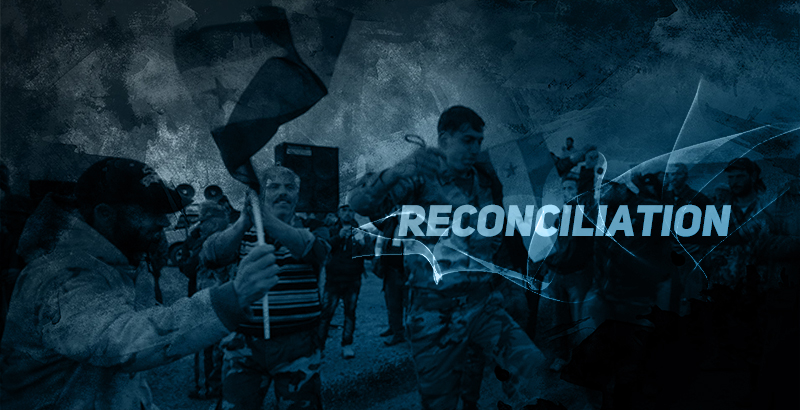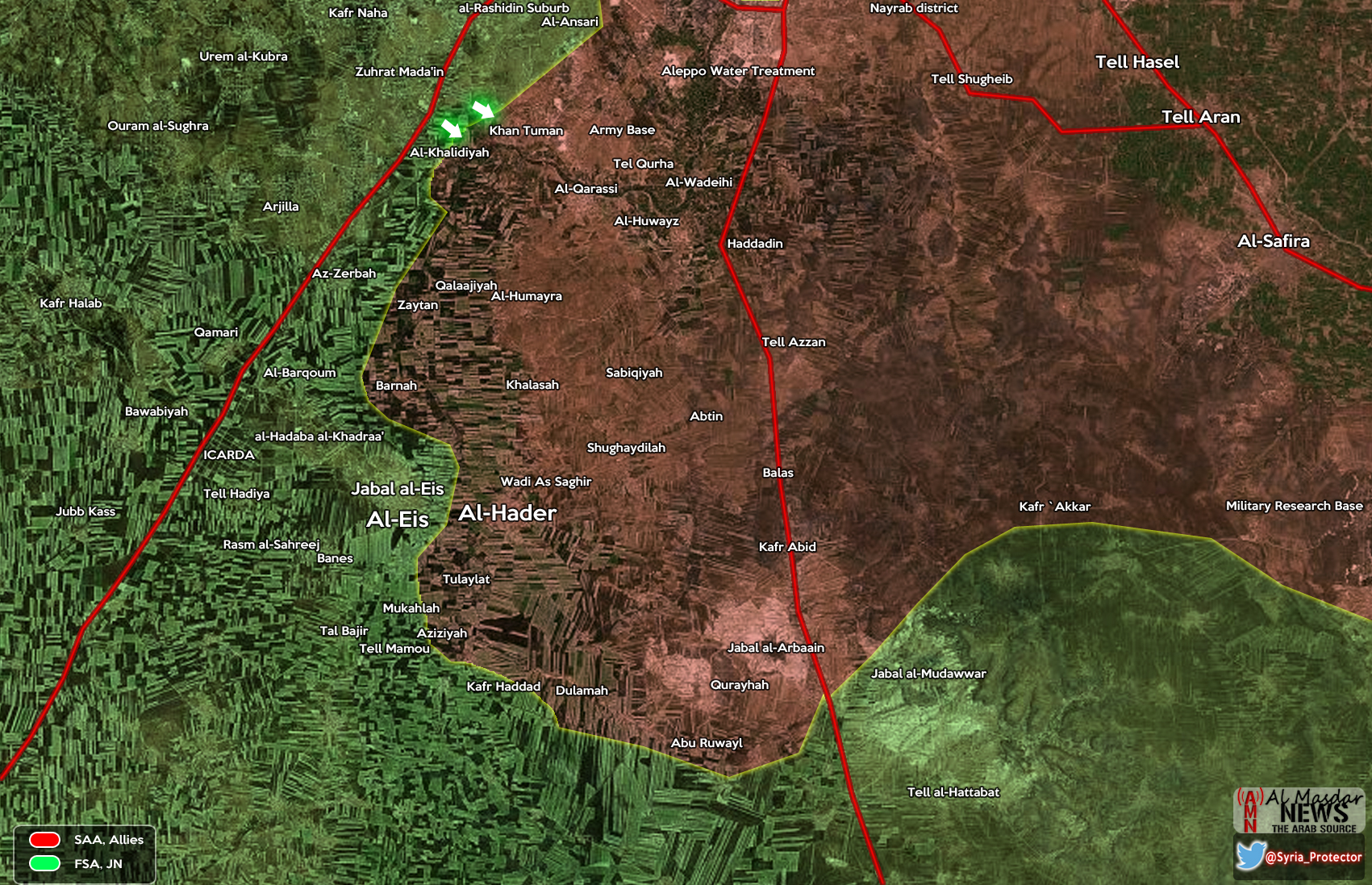The article provides a critical look at the reconciliation efforts on the ground in Syria.

Written by Leen Ibrahim exclusively for SouthFront
The Russian involvement in the Syrian war has taken a path different from the military one when the Moscow decided to work in the National Reconciliation. The reconciliation has been ongoing for two months, yet we still ask the question, has it been really fruitful?
In the Military airbase of Hmeimim, a centre for “Reconciliation of opposing sides in Syria” was established, many meetings were held and daily reports starting from on February 28 have been issued documenting this “reconciliation” and the ceasefire agreement. Checking the Reconciliation Center Bulletin on the website of the Russian Ministry of Defense (MoD) you will find reports about parties joining reconciliation and violations of ceasefire agreement. However, after nine weeks of meetings and dialogues and delegations and conferences and statements, this time seems not to be enough to reap the fruit of this work, and the clue to this is the question that many Syrians keep asking: what has changed after all those “meetings”?
One of the outcomes of those reconciliation sessions was the Hmeimim Statement, it was signed on March 9, 2016 when a group of “opposing sides” that have met at the centre and discussed several issues among of which is changing the Syrian constitution. This group later came to be known later as the Hmeimim Group.
If we start from the bottom of the statement, we find names of those who have signed it. “According to TASS, the Hmeimim group includes doctors, lawyers, engineers, journalists, social activities representing the Syrian organization National Action, Democratic Action in Syria movement, Secular Democracy organization, National Youth and Syrian Fatherland parties, as well as the International Red Cross and Red Crescent Movement and others”. Nonetheless, the background for those 36 representative figures who have signed the Hmeimim statement do not seem to be representative of the Syrians as it should be.
Suggesting that a vital part of this reconciliation is the Syrian national opposition we get a glimpse of hope that there is a different voice. Many of those figures who are introduced as opposition are loyal supporters of the government or at least have strong relations with it; many of them are retired officers, like Ilian Mousad, and Ahmad Alkousa who is well known to his relationship with intelligence offices, others are in direct relationship with government figures, like Majd Niazy whose strong support of President Assad is no secret to anyone yet all of a sudden became “an opposition member”; and here we realize the strange contextualization of the words “opposition” and “opposing.
On another level comes the question of the experience those who represent us “the people” have. As those representatives are supposed to be discussing a “political solution” to the Syrian crisis, it is worth noting that many of them are unknown and have no political background or history; there is no clue on the criteria according to which those figures were invited to this reconciliation to represent Syrians. It is fundamental that such standards be announced to have more credibility and get better results and trust from the public. A very simple example is Joseph Jreige who is an only an engineer, but there is no clear reason why has he been chosen to be representative of Syrians. Another sample is Badr Al Hammoud who was introduced in that statement as a “civil Activist from the Eastern region”, as well as the “secular and democratic activist, poetess and writer” Ghada Youssef, and Michele Arnouk “a secular democrat in the civil a society and a writer”. Such vague descriptions cannot gain the trust of the people, what people need now is someone they can rely on, someone who can speak for them and who can understand their pain. Since Moscow has been a major player in the Syrian arena for five years and should be more careful with the names whose success or failure indicates Moscow’s success or failure as well.
More interestingly, 12 of the 36 names included in this document belong to Syrian political parties, but checking the list of licensed parties in Syria as of January 21, 2015 we found that 4 were not on that list even:
- The National Convention Party, represented by Ilian Mousaad
- The Syrian Peace Party, represented by Hani Khouri
- The National Bloc Party, represented by Marwa Al Itouni
- Restoration and Development Party, represented by Mustafa Qalaaji
Those parties do not have real activity on the Syrian political checking arena and their social media pages, if any, explains it all as they are not known in Syria. They revolve around themselves and dedicate the mentality of glorifying the figure of the leader, like Ahmad Al Kousa whose photos take up 95% of his party’s Facebook page.
Another weakness point is that those representatives do not tend to show a strong attitude or any experience in the political domain. We heared many contradicting statements issued randomly. Those statements do not reflect the strngth of a unified atand to work together for the benefit of the Syrians.
Shorlty after signing the Hmeimim statement Majd Niazy announced that her party has withdrawn from the Hmeimim statement and refused it as a protest against the article that is “the nndicateecessity to form a group that includes religion men and representatives of armed militias when drafting a new constitution”. Her party was of the many parties have announced that this article was added to the statement after it was signed, which makes the Russian management of those meetings and agreements lose its credibility.
Another participant of a reconciliation meeting, Saleh Alkhatib Albaldani, has announced that he has been fooled as “no one has told him when he was invited by the regime to the reconciliation meeting that he would meet opposition of the inside nor with the Russians”; so Mr Al Khatib was going to the Russian military airbase of Hmeimim but did not expect to meet with any Russians.
This reconciliation and the talk about a political solution and refusing any military solution are unrealistic in comparison to the Russian presence on the ground. If all those endeavourers to reconciliation and attempts to reach an agreement on a united stand were really going well, why is the ceasefire being violated daily, why are those ‘representatives’ not standing on firm ground and showing a solid and coherent attitude toward the political situation in Syria? Liberating Palmyra on March 27 was not the result of a dialogue or a political solution; it was done by fighters on the ground through a real battle. The situation now on Syria is much bigger than just a political conflict; it is a global army of terrorists supported by entire countries.

How does the Russian MoD actually think that a talk about a “political solution” is possible? Does the Russian MoD actually believe that this is what the Syrians need after five years of fighting and political instability? The way the Russian MoD deals with this, starting with the representatives who actually seem to represent only themselves, moving to the parties that run in closed circles much reflects the content of those meetings and agreements, especially when after two months of “reconciliation” and ceasefire we find Aleppo today in a situation worse than ever. If this reconciliation was working well, why do we find people involved in it quitting or giving statements showing hectic and unsystematic judgments and attitudes towards other opposing parties and entities? The mere fact that Moscow really believes that people who have not been able to unify for five years will now be able to change themselves that simply shows how naïve this reconciliation is.

Opposite to this “successful reconciliation process” we can see heavy clashes and progress of terrorist groups on the ground in some parts of Syria that significantly increased during the last month. For example, in Aleppo, Syrian forces lost Al-Eis. Heavy clashes are ongoing right now at Khan-Tuman and Al-Khalidya [SF editor: according to premilitary reports Khan-Tuman and Al-Khalidya are fallen on May 6].
As for ISIS, it has also succeeded in taking over Afshanah, Kuways, Masudiyah, Hayrat al-Kabirah, Juh al-Ali, Khunaysir, Zabad, Akkill, Hayat al-Saghinah, Al-Qlay’ah, Khirbat al-Tawbah, Shabibaa, amidiyah al-Kabirah, Hamidiyah al-Saghirah, Rasm al-Haji.

Understanding those losses it is no secret to anybody that all we have now is a sum of fabricated reports that have been introduced to Moscow and the international community without any actual realization of their content on the ground.
SF editor’s comment:
The article describes the negative sides of the situation on the ground. However, it doesn’t explain “why this became possible”.
The Syrian war is a complicated conflict which involves interests of a wide range of regional and world powers. The most involved of them are: the USA, Russia, Saudi Arabia, Iran, Qatar, Turkey.
The USA, Saudi Arabia, Turkey and Qatar are definetely not interested in any kind of a peace process that won’t allow them to set a proxy government in Syria. They were forced to the negotiations by the Russian air campaign and the Syrian-Iranian success on the ground. However, the ongoing “peace process” is a part of their mid-term strategy in the Arab country.
The Russian involvement in the conflict is limited by a complicated economic situation despite the official version of the Russian media. This doesn’ allow it to conduct a full-scale military operation in Syria. Furthermore, the ongoing crises in Ukraine and in the Central Asia could be more important for the Russian security.
It will be wrong to suppose that the Russian Ministry of Defense doesn’t understand the strategic implications of this situation. However, it continues to take steps in order to gain any possible success from the ongoing reconciliation process.
Military developments in Aleppo City and in the whole province has next important characteristics:
- They are ongoing under the conditions of limited forces and facilities
- The sides are involved in a close combat, often, in urban areas
- The Syrian government has an advantage in the air
In this situation, the only successful solution is to attrit the militants, bring them into the offensive. Thus, the loyalists are able:
- Conduct air strikes against the contentrations of the militants’ forces
- Militants involve themselves in heavy clashes in urban areas where the defense has an advantage
- This draws forces and facilities of the armed groups in the area
When points 1-3 are done, the government forces gain a ground for successfull advances.







Russian belief in talks with terrorists and traitors is delusional, and the results are there to see.
Govenmenr-held part of Aleppo is being shelled more than ever. DId the Russianslose all their acumen and balls, all of a sudden? They have suffered deaths of heroes, no sense of humiliistion caving in?. Who will take Russia seriously after this, how will she be reborn as a world power?
OUr dead heros are writhing in their graves, and I am sick with disgust.